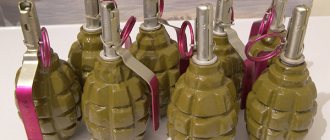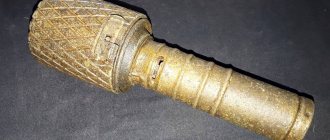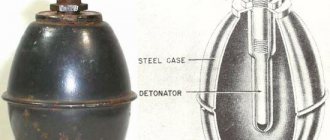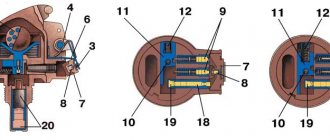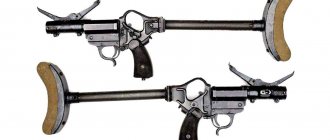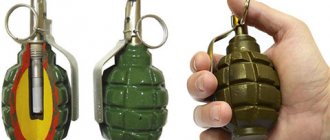Video RShG-1
RShG-1 with a modular warhead in thermobaric equipment is a soldier’s individual weapon, which has high efficiency in cumulative, high-explosive, fragmentation and incendiary effects simultaneously. For the first time in the world, its design features a shaped charge that forms when interacting with an obstacle and reliably hits lightly armored vehicles. The design of the warhead is patented and has no analogues in the world. The warhead of the grenade was borrowed from the TBG-7 grenade, and the jet engine from the RPG-27.
The RShG-1 rocket-propelled assault grenade is a rocket with a thermobaric warhead of 105 mm caliber (otherwise called “volumetric explosion ammunition”) and a powder jet engine, which is completely exhausted in the barrel of a disposable starting device. The RShG-1 warhead contains approximately 1.9 kg of fuel mixture, which, when detonated by a fuel-air cloud, gives a high-explosive effect comparable to the detonation of 5-6 kg of TNT. Stabilization of the grenade along the trajectory is carried out using folding stabilizers and the axial rotation they impart to the grenade.
The RShG-1 rocket-propelled assault grenade was created on the basis of the RPG-27. The main difference between the RShG-1 and RPG-27 is the thermobaric warhead of the RShG-1 missile, designed to combat lightly armored vehicles, fortifications and enemy infantry. At the same time, a high degree of unification was achieved. In particular, only the sighting device was changed in the launching device to increase the firing range. The starting device is a monoblock pipe made of fiberglass. The trigger device is covered at the ends with rubber caps that can be destroyed when fired. To bring it into the firing position, the safety pin is removed and the sighting devices are brought into the firing position, while the firing mechanism is cocked, and the grenade can be launched by pressing the trigger lever. If it is necessary to transfer the grenade back to the stowed position, the trigger mechanism is removed from the combat cocking when lowering the rear sight of the sight to a horizontal position and fixing it with a pin.
The RShG-1 with a disposable grenade launcher, while retaining all the advantages of the basic models, is equipped with new warheads with multi-factor lethality and is capable of hitting covered and open manpower, unarmored and lightly armored vehicles on the battlefield. The implementation of these developments became possible only through the use of a fundamentally new approach to the design and production of samples. This is, first of all, a block-modular principle of product development. It is based on the development and production of a wide range of block modules.
The use of universal modules in the design of grenades has significantly reduced the costs of their development and mass production. Experts know that when launching a new sample into a series, such costs amount to up to 50% of the cost of the pilot batch with its optimal volume (at least 6000 pieces). In modern conditions, due to a shortage of funds, this factor is becoming one of the main ones. Another important feature is the ease of the process of mastering combat use and operating new models by troops. A fighter who has the skills to handle the RPG-27 can easily use the RShG-1 on the battlefield without special retraining.
RShG-1 has successfully occupied a “niche” in the armament system of the ground forces and is intended for use with the greatest efficiency by special forces units, reconnaissance and sabotage groups. According to experts, this type of weapon, based on the “cost-effectiveness” criterion, at the time of its creation, had no equal in the world. In 2000, the RShG-1 was adopted by the Russian Army and began to be offered for export. According to the mechanism of impact on the target (blast wave and thermal effect from detonation of a cloud of fuel mixture sprayed in the air), this grenade is similar to the RPO-A infantry rocket flamethrower, however, due to a different classification (“grenade” and not “flamethrower”), the RShG-1 began to arrive for use with conventional infantry units, and not with flamethrower units of chemical forces.
Rocket Assault Grenades
The experience of local conflicts in the last decades of the last century has shown that the available infantry weapons do not always meet the requirements of the time. For example, when fighting Afghan or Chechen armed forces, anti-tank rocket launchers and grenades were often overpowered. The cumulative effect was simply useless, and the high-explosive and fragmentation effect of anti-tank ammunition did not ensure reliable and guaranteed defeat of the enemy. The weapons of some units of the Soviet armed forces included rocket-propelled flamethrowers, but the rest of the soldiers were forced to use only the weapons that were available to them. Based on the results of the first war in Chechnya, it became finally clear that the troops needed new jet weapons. Its development was undertaken by the State Research and Production Enterprise Basalt. When creating a new type of weapon, two main requirements were taken into account. Firstly, it was necessary to minimize the price of weapons, since the financial condition of the army by this time left much to be desired. Secondly, it was necessary to ensure the maximum possible power of ammunition when firing at manpower, shelters and lightly armored vehicles. It was these two factors that ultimately shaped the appearance of the new weapon.
In the light of recent wars, the main purpose of promising weapons was seen to be the destruction of long-term firing points and similar fortified structures. For this reason, the new systems received the common name “Rocket Assault Grenade” or RShG. The word “grenade” in the name appeared for exactly the same reasons as in the case of the anti-tank RPG-18 or RPG-22. Rocket-propelled assault ammunition was supposed to be made disposable, which, in accordance with the nomenclature of weapons adopted in the country, was designated by the word “grenade”.
In the mid-eighties, the RPG-26 "Aglen" and RPG-27 "Tavolga" rocket-propelled anti-tank grenades were adopted by our army. They differed from previous grenades of their class in higher characteristics, as well as the possibility of reverse transfer from a combat position to a traveling one. Previous grenades did not have this capability. Over the course of several years, the Soviet defense industry managed to master the mass production of new rocket-propelled anti-tank grenades. This is probably why the Basalt employees decided to make new RShGs based on them.
As a result of the modernization and processing of anti-tank ammunition, two versions of assault grenades appeared: RShG-1 and RShG-2. When creating them, the designers tried to achieve maximum unification both among themselves and with anti-tank grenades.
RShG-1
The RShG-1 rocket-propelled assault grenade is a redesigned RPG-27 Tavolga system. The assault grenade launcher almost completely retained the appearance of the anti-tank grenade device. During the modification, only the sighting devices were changed, which was due to the different flight ballistics of the ammunition. Otherwise, the starting device remains the same: a foldable fiberglass pipe, closed at the ends with rubber caps. When fired, the latter are destroyed. Before firing, the fighter must pull out the safety pin, unfold the sights and expand the launch tube. During these procedures, the firing mechanism is cocked. The shot is fired using a special lever. The soldier has the ability to transfer the grenade from the combat position back to the traveling position. To do this, the trigger mechanism is removed from cocking, and the sights are folded and secured with a pin.
Photo by A.V. Karpenko
The greatest interest in the RShG-1 system is its ammunition. It was created on the basis of RPG-27 and TBG-7V rounds (ammunition for the RPG-7 grenade launcher). From the first they took the tail section with a jet engine and stabilizers, from the second - the warhead. The result was a 105 mm caliber rocket munition carrying a thermobaric warhead. Its interesting feature is the use of a leading shaped charge. If necessary, it penetrates the protection of lightly armored vehicles, after which a fuel mixture weighing 1.9 kilograms comes into play. Its high-explosive effect, depending on specific conditions, is equivalent to 5-6 kilograms of TNT.
The grenade itself is ejected from the launcher using a solid fuel jet engine. The amount of charge is selected in such a way that it burns out completely before the grenade exits the launch tube. Thanks to this, the shooter does not risk getting burns. In this case, a dangerous zone with a radius of about 30 meters is formed behind the launcher in a sector 90° wide. After exiting the tube, the grenade deploys tail fins mounted at an angle to the flow. They spin the ammunition and thereby ensure its stability along the trajectory.
The 105-mm RShG-1 rocket-propelled grenade weighs 8.3 kilograms and in firing position has a length of 1135 millimeters. The jet engine throws a grenade at a speed of 130 meters per second, which is enough to effectively hit targets at a range of up to 200 meters. The maximum firing range is three times higher. The accuracy of the hit depends both on the skill of the shooter and on external factors: side wind, target visibility, etc.
RShG-1 and RShG-2 rocket-propelled assault grenades
RShG-2
Simultaneously with the first model rocket-propelled assault grenade, a similar system called RShG-2 was developed, based on the design of the RPG-26 “Aglen”. As in the case of RShG-1, developments in anti-tank grenades were widely used. For example, the launcher received only new sights and retained all other features of its design. The procedure for using the RShG-2 grenade is similar to using the RShG-1 and RPG-26.
The main innovation in the RShG-2 system was rocket-propelled ammunition. Since the caliber of the original Aglen anti-tank grenade of 73 millimeters was smaller than that of the Tavolga and, as a result, the RShG-1, Basalt employees had to develop a new thermobaric warhead based on the TBG-7V round. In fact, the warhead of the RShG-2 grenade is a smaller grenade tank for the RPG-7 with a smaller charge of the fuel mixture. The fuse remained the same. The warhead is delivered to the target using the tail of a grenade, borrowed from the ammunition of the RPG-26 system. The solid propellant charge pushes the grenade out and burns out completely before it leaves the launch tube. Along its trajectory, the grenade is stabilized by rotation due to folding planes. The warhead of the RShG-2 shot contains about 1.15 kilograms of a fuel mixture with a high-explosive effect at the level of 2.5-3 kilograms of TNT.
The smaller caliber of the RShG-2 rocket-propelled assault grenade compared to the first model caused noticeable differences in other characteristics. Thus, a ready-to-use grenade weighs only four kilograms and has a length of 770 millimeters. The shot leaves the launcher with an initial speed of 144 m/s and flies at a distance of up to 350 meters. The effective firing range is one hundred meters less.
Photo by A.V. Karpenko
Common Features and Benefits
Both assault grenades are capable of hitting enemy personnel, lightly armored and unprotected vehicles, as well as shelters. Thanks to the use of original shots, they are able to break through brick and concrete walls of relatively small thickness. This allows you to destroy an enemy inside a building without directly hitting a window or doorway. The fuel mixture sprayed by the grenade allows it to hit targets both indoors and in open spaces. An additional advantage of the RShG-1 grenade is its leading shaped charge, thanks to which part of the fuel mixture is guaranteed to fall behind a wall or armored barrier, which significantly enhances the effect of the ammunition.
In addition to their characteristics, the new assault grenades also have economic advantages. Due to the widespread use of old developments and products mastered in production, RShG-1 and RShG-2 grenades require almost no changes in the technological process and can be produced on the same production lines as “Aglen” or “Tavolga”. In fact, to assemble assault grenades, all that is required is to organize the production of new sighting devices and warheads for the RShG-2. All other elements of the systems are borrowed from existing ones. Another advantage of assault grenades was the ease of training personnel. A fighter who has learned to use anti-tank RPG-26 and RPG-27 is able to quickly master the use of RShG-1 and RShG-2.
The ease of production, low cost, ease of use and training attracted the interest of the Russian army, and in 2000 both grenades were put into service. Assault grenades of both models are mass-produced and supplied to ground forces units. It is noteworthy that, unlike jet flamethrowers, RShG-1 and RShG-2 are sent not only to radiation, chemical and biological defense troops, but also to other branches of the military. According to reports, both models of grenades are widely used by special forces in counter-terrorism operations. With their help, special forces destroy criminals hiding in fortified buildings.
Impact of RShG on armored personnel carriers
Impact of RShG on a concrete shelter
Based on materials from the sites: https://world.guns.ru/ https://weaponland.ru/ https://otvaga2004.ru/ https://weaponplace.ru/

